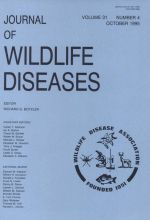To study the susceptibility of wading birds to eastern equine encephalitis (EEE) virus and to determine their potential as reservoir or amplifying hosts, fledgling glossy ibises (Plegadis falcinellus) and snowy egrets (Egretta thula) were captured in New Jersey (USA) and shipped to Colorado (USA) where they were experimentally inoculated with EEE virus. All 16 snowy egrets and 14 (93%) of 15 of the glossy ibises inoculated became viremic with moderate titers, and all survivors developed neutralizing antibody. Six ibises and two egrets died during the first week after inoculation, and EEE virus was isolated from the tissues of three birds. Our experimental results support field evidence about the relative involvement of glossy ibises and snowy egrets in the epizootiology of EEE virus in New Jersey.
How to translate text using browser tools
1 October 1995
EXPERIMENTAL INFECTION OF WADING BIRDS WITH EASTERN EQUINE ENCEPHALITIS VIRUS
Robert G. McLean,
Wayne J. Crans,
Donald F. Caccamise,
James McNelly,
Larry J. Kirk,
Carl J. Mitchell,
Charles H. Calisher

Journal of Wildlife Diseases
Vol. 31 • No. 4
October 1995
Vol. 31 • No. 4
October 1995
arbovirus
Eastern Equine Encephalitis virus
Egretta thula
experimental infection
Glossy Ibis
Plegadis falcinellus
reservoir competence




